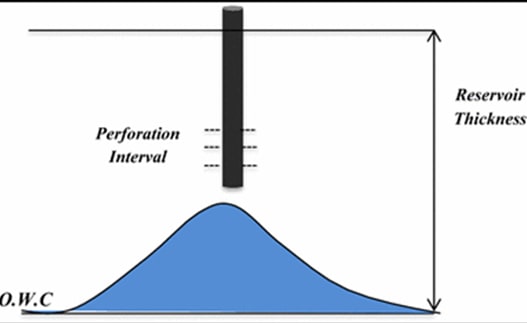Managing the cycle of water production, separation down-hole or at the surface, and disposal involves a wide range of oilfield services. These include data acquisition and diagnostics using downhole sensors; production logging and water analysis for detecting water problems; reservoir modeling to characterize flow; and various technologies to eliminate water problems such as conformance control and chemical shutoff technique.
Excessive water production due to conformance problems becomes an issue when it competes directly with oil production. This water usually flows to the wellbore through its own path, independent of the oil flow pathway. In such cases, a reduction of water production can often lead to a greater pressure drawdown and increase oil production rates.
conformance is defined as a measure of the degree of sweep efficiency during an oil-recovery flooding operation. Thus, it would probably appear, at first glance, that for the on-going process of oil-recovery flooding, a casing leak excessive-water-production problem occurring at one of the production wells does not negatively impact the sweep efficiency of the oil-recovery flooding operation. However, closer consideration shows that indeed it can; and, the negative impact can create a conformance problem.

Excessive water production during oil-recovery operations adds unnecessary operating-expense costs to the recovery of oil. The unnecessary operating expenses include water lifting, treating, handling, and disposal costs; they can also include environmentally-related and safety-related costs derived from, for example, possible heavy-metals and H2S being produced in the excessive and unnecessary water production.
The root cause of petroleum-reservoir conformance problems is spatial variation in the fluid-flow capacity because of reservoir permeability heterogeneity. In addition, oil recovery conformance problems can be exacerbated by, or dominated by, mobility induced viscous fingering. Mobility induced conformance issues and their resultant viscous fingering during oil-recovery flooding operations result from viscous oil being displaced by a relatively low-viscosity oil-recovery drive fluid (e.g. water).

Diagnosis of Conformance Problems
Conformance problems can be classified into two main categories:
- Near-wellbore problems
- Reservoir-related problems.
The diagnostic evaluation of conformance problems must consider these two conformance problem categories to pinpoint the source of the problem that might exist in a given area. The diagnostic evaluation of conformance problems consists of the following elements:
- Well testing and reservoir monitoring
- Well-testing methods and equipment
- Numerical modeling and simulations
NP LOGS Diagnostic Evaluation Procedures, Tools, and Strategies
It is important to emphasize that a key aspect for the successful diagnosis of any conformance problem is the integration of multiple evaluation procedures and tools. Information provided by the use of only one procedure could be misleading, as is the case of the exclusive use of water/oil ratio (WOR) diagnostic plots, which could be misinterpreted, and should not be used alone to diagnose the specific cause of a water production problem.
Also, as part of our strategy for attacking excess water production problems, it is advocated:
- starting the diagnostic process using information that you already have and
- if additional diagnostic methods are needed, choose methods to confirm or rule out the easiest problems first (and, by extension, diagnose the most difficult problems last).
This strategy can be applied to the diagnosing of most conformance problems.
